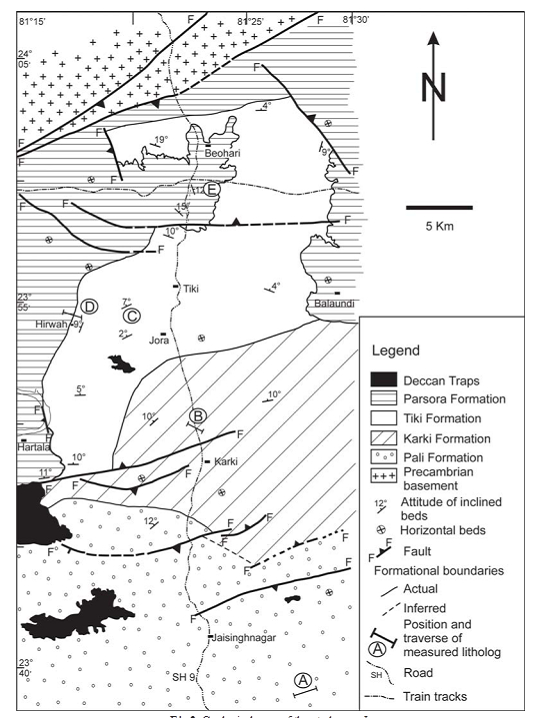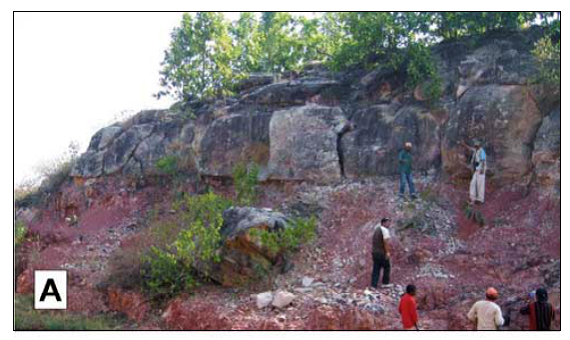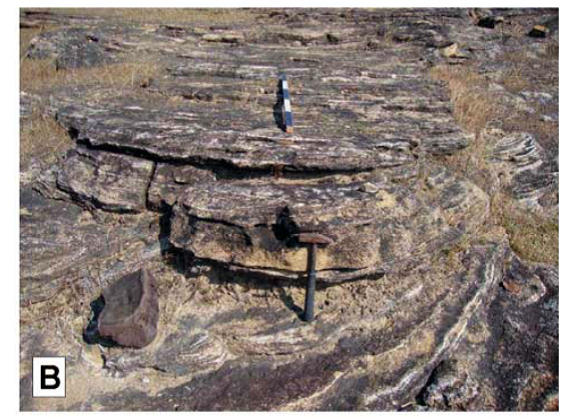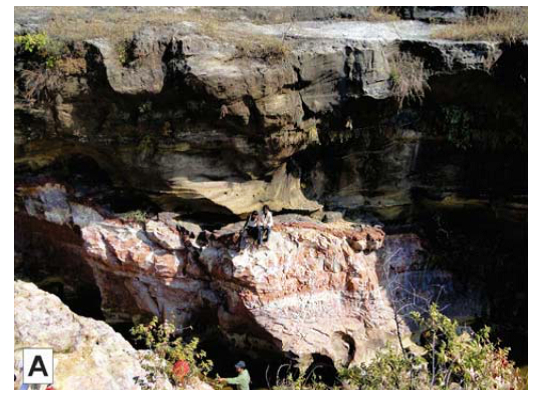Parsora Fm
Type Locality and Naming
South Rewa Basin: Johilla River section from Salaia to Bhaursen peak, with reference section in Parsora village along E - W trending belt of hummocks, north of Pali. This formation was named after the village Parsora of South Rewa area of Madhya Pradesh by Cotter (1917). Dutta and Ghosh (1972) gave it the status of a formation. [Original Publication: Cotter, G. DE P., 1917. A revised classification of the Gondwana system. Rec. Geol. Surv. Ind. 48 (1), 2 3-33; Dutta. P.K. and Ghosh, S.K., 1972a. Triassic sedimentation in Pali-Tiki Parsora area, Madhya Pradesh. Proc. 59th Sess. Ind. Sci. Congo pt, 3, Abst., 232-233; Dutta. P.K. and Ghosh, S.K., 1972b. Stratigraphy and sedimentation of Pali, Parsora, Tiki area in Rewa Gondwana basin, Madhya Pradesh. Report, Geol. Surv. Ind. Unpublished.]
[Figure 1: Geological map of Pali-Birsinghpur area where the type sections of Pali, Karki and Tiki formations are exposed (Mukherjee et al., 2012)]
[Figure 2: Geological map of Parsora-Kamardhi Nala area where the type section of Parsora Formation is located (after Mukherjee et al., 2012)]
Synonyms: It was earlier referred as the Mahadevas (Hughes, 1881), 'transitional bed' (Fiestmantel, 1882), Supra-Barakars (Hughes, 1884), and Parsora stage (Lele, 1964), Hartala Formation (Sukh Dev 1987; Tarafdar et al., 1993).
Lithology and Thickness
Siltstone to sandstone. The Parsora Formation begins with a basal siltstone-mudstone sequence succeeded upwards by an essentially sandy succession (Mukherjee et al., 2012). It is a predominantly multistoried sandstone unit with minor amount of siltstone and mudstone intercalations. The sandstones are white, yellow to yellowish-grey, greyish-yellow in color, medium to coarse grained, laminated to cross-bedded, feldspathic in composition. The sandstone contains clasts of various sizes of clay or thin impersistent interbands of lavender coloured mudstone. The frequency and size of clay clasts decrease gradually from lower to upper part, and there is concomitant increase in the percentage of white clay matrix. Associated with Parsora Formation is a characteristic polymictic conglomerate in the middle part containing sub-rounded pebbles of quartz, dark grey quartzite, jasper etc. set in ferruginous cement (Bandyopadhyay, 1978-79 in Mitra, 1993; Dutta and Ghosh, 1972; Mitra, 1993). A 5-6 m thick paleosol horizon with hematite/limonite concretions, goethite and calcrete was observed in the basal part of the Parsora Formation (Datta & Das, 2001). The formation is about 450 m thick (Sastry et al., 1977, Peter, 2009).
[Figure 3&4: Field photograph of basal purple siltstone overlain by thick sandstone (A) and trough cross-bedded sandstone in the Parsora Formation of Pali-Birsinghpur area (after Mukherjee et al., 2012)]
[Figure 5: A) Field photograph of the basal lithounits of the Parsora Formation in the type area (Mukherjee et al., 2012)]
Relationships and Distribution
Lower contact
The Parsora Formation has an unconformable contact with the underlying Tiki Fm (Peter, 2009; Mukherjee et al., 2012).
Upper contact
The upper contact is rather uncertain and has been variously interpreted. However, in Bandhavgarh Fort, the Jabalpur Fm overlies the very low dipping Parsora Formation suggesting a minor disconformity (Sastry et al., 1977). [Note: The Jabalpur Fm has been assigned to uppermost Jurassic, but this Parsora Fm to upper Triassic-lowermost Jurassic => a major hiatus would be implied? But age constraints require further investigation.]
Regional extent
South Rewa Basin: The Parsora Formation extends from Somarkoini in the north to Chota Daigaon in the west and beyond Murch-Pass in the east. They also occur as isolated outcrops in and around Beoharai hills.
GeoJSON
Fossils
Cyzicus and Estheriella (Ghosh et al. 1988) and flora Cladophlebis denticulta, Parsorophyllum indicum, Neocalamites foxii, Taeniopteris ? spatulta, Pterophyllum sahnii, Glossopteris sp., Vertebraria indica, Noeggerathiopsis hislopi, Schizoneura sp., Samaropsis srivastavai, Dicroidium hughesi, D. odontopteroides, D. sahnii, Araucarites parsorensis, Shenopteris, Daeniopsis is known (Feistmantel, 1882,1884; Seward, 1932; Saxena, 1952a; Sahni, 1932a; Lele, 1961a,b, 1962, 1964a, 1969a; Singh, G.,1974) from various localities of Parsora Formation.
Age
Depositional setting
Presence of thick siltstone-mudstone unit at the basal part of the Parsora Formation was taken as an evidence of initiation of deposition from suspension after a long hiatus by Mukherjee et al. (2012). According to these authors, a change in fluvial style is observed within the formation when thick multistoried very coarse- to coarse-grained sand bodies were deposited with repetitive occurrence of a thin (2-4 m) siltstone layer higher up in the succession. Dominance of the arenaceous units in comparison to the fine clastics and sand body geometry shows that the units were deposited under high flow regime. The thick multistoried sand bodies represent the main channel belt of the Parsora river system whereas the intermittent fine clastics suggest floodplain deposits (Mukherjee et al., 2012)
Additional Information
References
Cotter, G. DE P., 1917. A revised classification of the Gondwana system. Rec. Geol. Surv. Ind. 48 (1), 2 3-33; Dutta. P.K. and Ghosh, S.K., 1972a. Triassic sedimentation in Pali-Tiki Parsora area, Madhya Pradesh. Proc. 59th Sess. Ind. Sci. Congo pt, 3, Abst., 232-233; Dutta. P.K. and Ghosh, S.K., 1972b. Stratigraphy and sedimentation of Pali, Parsora, Tiki area in Rewa Gondwana basin, Madhya Pradesh. Report, Geol. Surv. Ind. Fiestmantel, 1882 Feistmantel, 1884 Ghosh et al. 1988 Ghosh et al., 2016 Hughes, 1881 Hughes, 1884 Lele, 1964 Lele, 1961 Lele 1962 a, b Lele 1964a Lele 1969a Mitra, 1993 Mukherjee et al. 2012 Peter, 2009 Raja Rao, 1983 Sahni, 1932a Saxena, 1952a; Seward, 1932; Sastry et al., 1977 Singh, G.,1974 Sukh Dev 1987 Tarafdar et al., 1993




